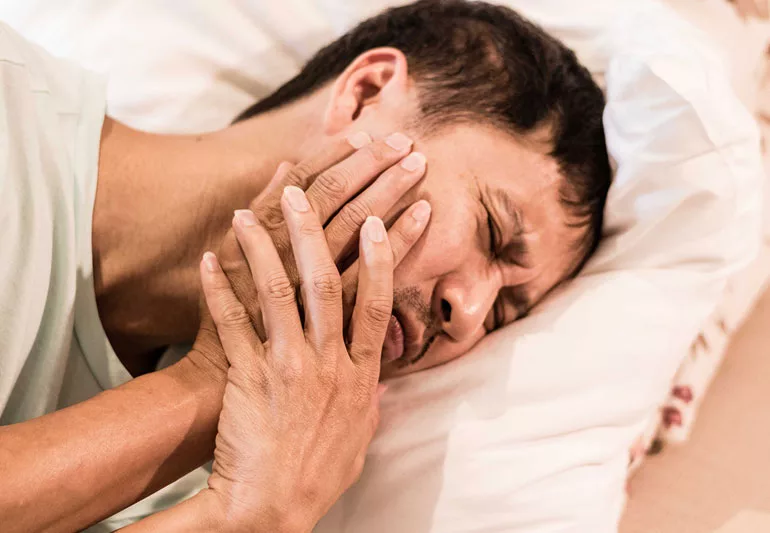
Temporomandibular disorders (TMD) and sleep apnea are two distinct conditions that can significantly impact an individual’s quality of life. However, recent research suggests a potential overlap in their pathophysiology and treatment considerations. As a Doctor of TMJ and Orofacial Pain and an active member of the American Board of Orofacial Pain, it is crucial to explore this correlation to enhance our understanding and optimize treatment outcomes for patients. In this blog, we will delve into the shared mechanisms, the potential bidirectional relationship between TMD and sleep apnea, and the implications for comprehensive management.
- Pathophysiological Overlap: Both TMD and sleep apnea involve the complex interaction of multiple anatomical structures, neural pathways, and functional systems. They share common pathophysiological factors, including inflammation, muscular dysfunction, and altered craniofacial morphology. Understanding these shared mechanisms is vital for a comprehensive approach to diagnosis and treatment.
- Muscular Dysfunction: Muscular dysfunction plays a significant role in both TMD and sleep apnea. In TMD, parafunctional activities, such as bruxism and clenching, can lead to muscle hyperactivity, myofascial pain, and restricted jaw movement. Similarly, sleep apnea involves the repetitive collapse of the upper airway during sleep, leading to increased activation of the oropharyngeal muscles in an attempt to maintain patency. This chronic muscle strain can contribute to orofacial pain and exacerbate TMD symptoms.
- Craniofacial Morphology: Abnormal craniofacial morphology, such as retrognathia or micrognathia, is a common finding in both TMD and sleep apnea patients. These anatomical variations can contribute to compromised airway space, increased muscle tension, and altered joint loading. The interplay between craniofacial morphology and its impact on TMD and sleep apnea underscores the importance of a multidisciplinary approach involving dentists, orthodontists, and sleep medicine specialists.
- Bidirectional Relationship: While TMD and sleep apnea share common features, emerging evidence suggests a potential bidirectional relationship between the two conditions. TMD may contribute to the development or exacerbation of sleep apnea by causing anatomical and functional changes in the upper airway. Conversely, sleep apnea-related factors, such as intermittent hypoxia and sleep fragmentation, can influence pain processing and exacerbate TMD symptoms. Recognizing this bidirectional relationship is essential for effective management.
- Comprehensive Treatment Considerations: Given the overlapping pathophysiology and bidirectional relationship, an integrated approach to treatment is paramount. Therapeutic interventions should focus on addressing both TMD and sleep apnea concurrently. This may involve a combination of oral appliance therapy, mandibular advancement devices, myofunctional therapy, physical therapy, and collaboration with sleep medicine specialists for managing sleep-related breathing disorders. Individualized treatment plans should be tailored to the patient’s specific needs, taking into account the severity and underlying causes of both conditions.
Conclusion
The convergence of TMD and sleep apnea presents an exciting opportunity to improve patient care through a holistic approach. Recognizing the shared pathophysiology and bidirectional relationship can help clinicians develop more effective treatment strategies. By working collaboratively across disciplines, we can optimize patient outcomes, alleviate symptoms, and enhance overall well-being. As healthcare professionals, it is our duty to remain informed about these overlapping conditions and provide comprehensive care to those affected by TMD and sleep apnea.
TMJ Treatment by Dr. Nojan Bakhtiari
Dr. Nojan Bakhtiari is a highly experienced cosmetic dentist and one of the leading providers of Botox for TMJ and headaches in New York City, NY. With years of experience and a commitment to providing the highest quality care, Dr. Bakhtiari is an expert in the use of Botox for the treatment of TMJ disorder and headaches.
Dr. Bakhtiari has a deep understanding of the underlying causes of TMJ disorder and headaches, and has extensive experience in using Botox to treat these conditions. He uses a combination of the latest techniques and technologies, including Botox injections, to provide his patients with the most effective treatment possible.
If you are looking for a safe and effective way to treat your TMJ disorder or headaches, Dr. Bakhtiari and his team are here to help. With their expertise and commitment to providing the highest quality care, you can trust that you will receive the best possible treatment for your condition.
To learn more about Botox & TMJ treatment by Dr. Nojan Bakhtiari & schedule your consultation today!

